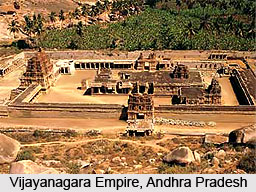 Vasireddy clan involves rulers like Mallikarjuna, Sadasiva Nayudu, Chinapadmanabha Ramanna Nayudu and Vasireddy Venkatadri Nayudu, amongst several other ancient rulers of the Vijayanagara Empire in Andhra Pradesh.
Vasireddy clan involves rulers like Mallikarjuna, Sadasiva Nayudu, Chinapadmanabha Ramanna Nayudu and Vasireddy Venkatadri Nayudu, amongst several other ancient rulers of the Vijayanagara Empire in Andhra Pradesh.
History of Vasireddy Clan
The feudal lords who were the emperors of the kingdoms were termed as `Nayakas`. Their empire, known as Vijayanagara Empire was damaged during the Tallikota War, which had occurred during 1565 AD. During this time, the states of Bidar, Golconda, Ahmednagar and Bijapur had conspired and fought battles against Vijayanagara Empire. The Sultans of Bijapur and Golconda confiscated the kingdoms which were controlled by the Vijayanagara Empire. Reddy, Kamma and Velama were made the kings of numerous kingdoms, by the Sultans of Golconda and Bijapur. However, the revenue collected by these rulers passed on to these Sultans. This led to the growth of the system called `Zamindari` or `Samsthanamus`.
The origin of the Vasireddy clan dates back to the 1413 CE. Inscriptions of Pothineedu at the region of Pithapuram bear testimony to the existence of this clan in Andhra Pradesh. It is said that Pothineedu used to rule an area close to Pithapuram prior to the decline of the dynasty of Musunuri Nayaks at Warangal. He had built several temples near the delta of Godavari River and had planted as many as 4, 60,000 palm or `Taadi` trees.
Rulers of Vasireddy Clan
Some of the prominent rulers of Vasireddy Clan are as follows:
Mallikarjuna
Mallikarjuna was another important ruler of Vasireddy clan who is believed to have ruled from 1500 to 1527 AD. He had declined to pay the regular taxes to Kuli Qutb Shah, who was the then Nawab of Golconda. This, consequently, led to a fierce battle with Haider Jung, the commander. During this battle, Haider Jung as well as Mallikarjuna died and his wife was said to have committed `Sati`. Sadasiva Raya, who was the son of Mallikarjuna, was looked after by one of their wealthy relatives named Kodali Ramabhupati, in the village of Nutakki in Guntur district.
Sadasiva Nayudu
Vasireddy Sadasiva Nayadu was the ruler of Nandigama paragana from 1550 to 1581 CE. Ibrahim Qutb Shah, the Nawab of Golconda had granted him the paragana of Golconda. Madineedu, Gurivineedu, Chinavenkatadri and Gangineedu, who were his grandsons, were said to have ruled the kingdom from 1600 to 1670 CE.
Chinapadmanabha Ramanna
Chinapadmanabha Ramanna Nayudu was granted as many as 500 villages from Tanisha during 1685 CE. According to a legend, Sultan Tanisha experienced an issue with his stubborn horse, which however, was brought under control by Ramanna. Impressed, the Sultan had rewarded him the `Sardeshamukhi`, which consisted of 500 villages. The villages were Kondavidu, Vinukonda, Kammamettu or Khammam and Nandigama. He ruled till 1710 and created a fort at Chintapalli. Lakshmipati, Pedanarasanna, Rajamouli, Chinanarsanna, Chinaramalinga, Chandramouli and Buchiraghava were his successors who controlled the empire till 1760. Jaggayya had ruled Chintapalli from 1763. The troops of French East India Companyhad killed him, who were sent by Basalat Jung. Jung was the brother of the Golconda Nawab, in the year 1771. Acchamma, who was the wife of Jaggayya had committed Sati. Venkatadri, the son of Jaggayya had recovered the region of Chintapalli around 177 and was renowned for being a kind ruler.
Venkatadri Nayudu
Vasireddy Venkatadri Nayudu, who was the king during the years 1783 to 1816, had moved his capital to Amaravati which is located near the ancient site of Dhanyakatakam, close to Krishna River. He patronised literature and arts and was credited for creating several temples near the delta of Krishna River. He had renovated the temples situated at Ponnuru, Chebrolu, Mangalagiri and Amaravati.



















